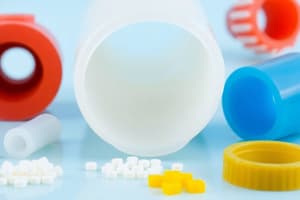Podcast
Questions and Answers
What are the initial forms of polymers mentioned in the context of materials engineering?
What are the initial forms of polymers mentioned in the context of materials engineering?
- Liquids, powders, and granules (correct)
- Cements and ceramics
- Gases and solids
- Fibers and gases
Which processing methods can be applied to powders and granules of polymers?
Which processing methods can be applied to powders and granules of polymers?
- Centrifugation and crystallization
- Sintering and bleeding
- Extrusion and injection (correct)
- Evaporation and filtration
What property of the final product significantly influences the choice of processing method for polymers?
What property of the final product significantly influences the choice of processing method for polymers?
- The color of the polymer
- The desired attributes of the product (correct)
- The shipping method
- The production location
What is required for thermoplastics to transition from a solid to a plastic state during processing?
What is required for thermoplastics to transition from a solid to a plastic state during processing?
How are finished thermoplastic products typically solidified after being molded?
How are finished thermoplastic products typically solidified after being molded?
Which of the following is NOT a stage in the processing of thermoplastics?
Which of the following is NOT a stage in the processing of thermoplastics?
What happens to semi-finished products like plates and films during thermoplastic processing?
What happens to semi-finished products like plates and films during thermoplastic processing?
What characterizes the versatility of polymers in their various initial forms?
What characterizes the versatility of polymers in their various initial forms?
What is the primary role of additives in polymer formulation?
What is the primary role of additives in polymer formulation?
What is the primary function of technological modifiers in polymer formulation?
What is the primary function of technological modifiers in polymer formulation?
What initiates the chemical reaction in thermosets processing?
What initiates the chemical reaction in thermosets processing?
What happens to the shaped object after the reaction in thermosets processing is completed?
What happens to the shaped object after the reaction in thermosets processing is completed?
Which of the following is NOT an example of a technological modifier?
Which of the following is NOT an example of a technological modifier?
Which of the following components is NOT considered an additive in polymer formulation?
Which of the following components is NOT considered an additive in polymer formulation?
How do specific modifiers differ from technological modifiers?
How do specific modifiers differ from technological modifiers?
What type of materials can be mixed with liquids in thermosets processing?
What type of materials can be mixed with liquids in thermosets processing?
What role do thermal stabilizers play as specific modifiers?
What role do thermal stabilizers play as specific modifiers?
Which technological modifier would be best utilized to prevent degradation during polymer manufacturing?
Which technological modifier would be best utilized to prevent degradation during polymer manufacturing?
Which property is primarily enhanced by the use of plasticizers in polymer formulation?
Which property is primarily enhanced by the use of plasticizers in polymer formulation?
What is the significance of using modifiers like mineral fillers in polymer formulation?
What is the significance of using modifiers like mineral fillers in polymer formulation?
Why is the thoughtful use of modifiers essential in material formulation?
Why is the thoughtful use of modifiers essential in material formulation?
Which of the following best describes the role of surface modification agents?
Which of the following best describes the role of surface modification agents?
What temperature range is required for an object to be demolded in thermosets processing?
What temperature range is required for an object to be demolded in thermosets processing?
During material formulation, what is the purpose of incorporating various additives?
During material formulation, what is the purpose of incorporating various additives?
Flashcards
Thermoplastics
Thermoplastics
Materials that can be repeatedly softened by heating and solidified by cooling, allowing them to be reshaped multiple times.
Thermoplastic Processing
Thermoplastic Processing
A process where thermoplastics are heated to a molten state and then shaped in a mold before cooling and solidifying.
Thermoplastic Starting Materials
Thermoplastic Starting Materials
Solid, powdered, or granular materials that are heated to form a moldable mass.
Plasticization
Plasticization
Signup and view all the flashcards
Mold or Die
Mold or Die
Signup and view all the flashcards
Cooling System
Cooling System
Signup and view all the flashcards
Finished Product
Finished Product
Signup and view all the flashcards
Thermoplastic Reprocessing
Thermoplastic Reprocessing
Signup and view all the flashcards
Thermoset Processing
Thermoset Processing
Signup and view all the flashcards
Thermoset Chemical Reaction
Thermoset Chemical Reaction
Signup and view all the flashcards
Thermosets Catalysts and Initiators
Thermosets Catalysts and Initiators
Signup and view all the flashcards
Thermosets Initiators
Thermosets Initiators
Signup and view all the flashcards
Thermosets Catalysts
Thermosets Catalysts
Signup and view all the flashcards
Thermosets Shaping
Thermosets Shaping
Signup and view all the flashcards
Polymer Formulation
Polymer Formulation
Signup and view all the flashcards
Polymer Additives
Polymer Additives
Signup and view all the flashcards
Technological Modifiers
Technological Modifiers
Signup and view all the flashcards
Specific Examples of Modifiers
Specific Examples of Modifiers
Signup and view all the flashcards
Specific Modifiers
Specific Modifiers
Signup and view all the flashcards
Specific Applications of Modifiers
Specific Applications of Modifiers
Signup and view all the flashcards
Additives in Formulation
Additives in Formulation
Signup and view all the flashcards
Role of Additives in Material Properties
Role of Additives in Material Properties
Signup and view all the flashcards
Examples of Common Additives
Examples of Common Additives
Signup and view all the flashcards
Importance of Additive Selection
Importance of Additive Selection
Signup and view all the flashcards
Study Notes
Introduction
- Polymers exist in various forms (liquids, powders, granules).
- Processing polymers is crucial for creating finished products.
- Polymer processing methods (e.g., molding, extrusion, injection) vary based on desired product attributes.
- The choice of processing method depends on the desired product properties, manufacturing limitations, and the specific application.
- Polymer processing involves a blend of technical skill and creativity to utilize unique polymer properties.
Thermoplastic Processing
- Processing begins with powder, granules, or semi-finished products (plates, sheets, films).
- External or internal energy (heating/friction) transforms the polymer from solid to plastic/molten state.
- Molding using a die shapes the material.
- Cooling solidifies the polymer into the desired form.
- The finished product can be reprocessed or recycled.
Thermoset Processing
- Thermoset processing involves mixing liquids, pastes, or powders.
- Initiator and catalyst control the chemical reaction, usually beginning with mixing or applying heat.
- Products are typically shaped during or after the initiation of the reaction.
- Reaction completion solidifies the product, at which point it cannot be reprocessed.
Polymer Formulation
- Polymers often need additives to meet specific application requirements.
- Additives enhance thermal stability, weather resistance, fire safety, and other properties.
- Modifiers like plasticizers, fiber reinforcements, and mineral fillers adjust flexibility, strength, and other specific characteristics.
- Modifiers ensure polymer properties meet specific needs for different applications.
Technological Modifiers
- Technological modifiers are added to enhance a material's properties, processing, and handling.
- Examples include catalysts, surface modifiers, dispersing agents, and inhibitors.
- Modifiers are used to accelerate reactions, improve adhesion, prevent degradation, and ensure homogeneity.
Specific Modifiers
- Specific modifiers address specific needs for targeted polymer modification.
- Examples include thermal stabilizers, antioxidants, colorants, reinforcement agents, and surface modification agents.
- Specific modifiers enhance heat resistance, provide color, increase strength, and improve adhesion.
Additive Types
- Thermal Stabilizers: Enhance temperature resistance.
- Antioxidants: Prevent oxidation-related degradation.
- Coloring Agents: Provide desired color.
- Reinforcement Agents: Improve strength and rigidity.
- Surface Modification Agents: Improve adhesion to other substrates.
Studying That Suits You
Use AI to generate personalized quizzes and flashcards to suit your learning preferences.




